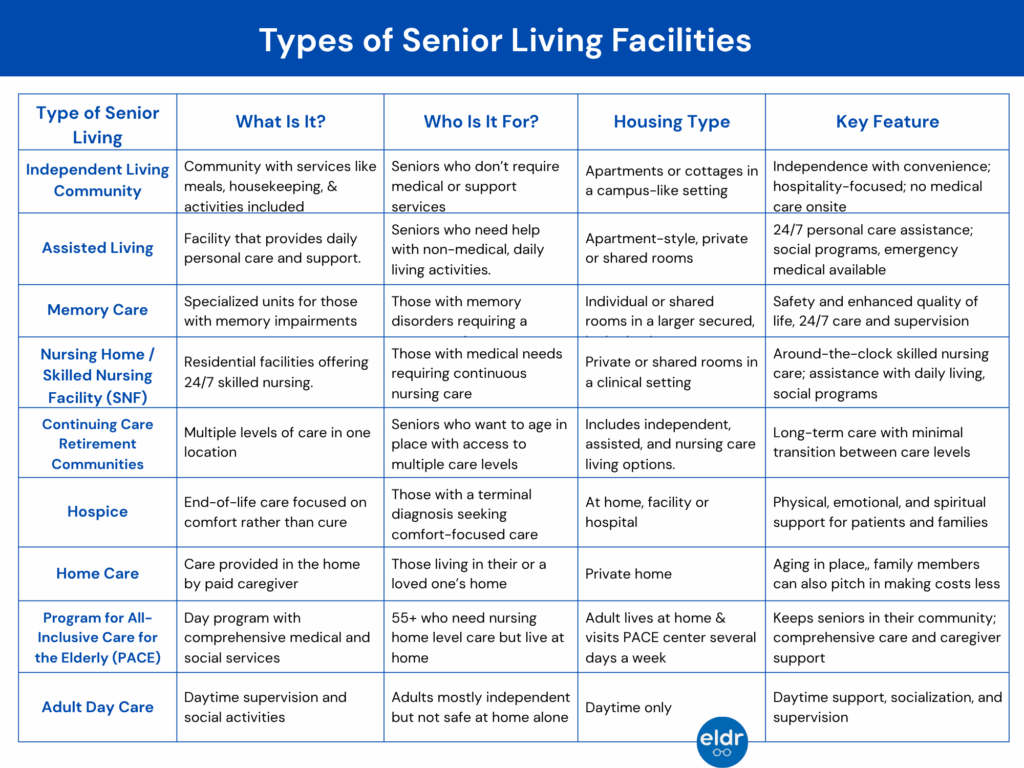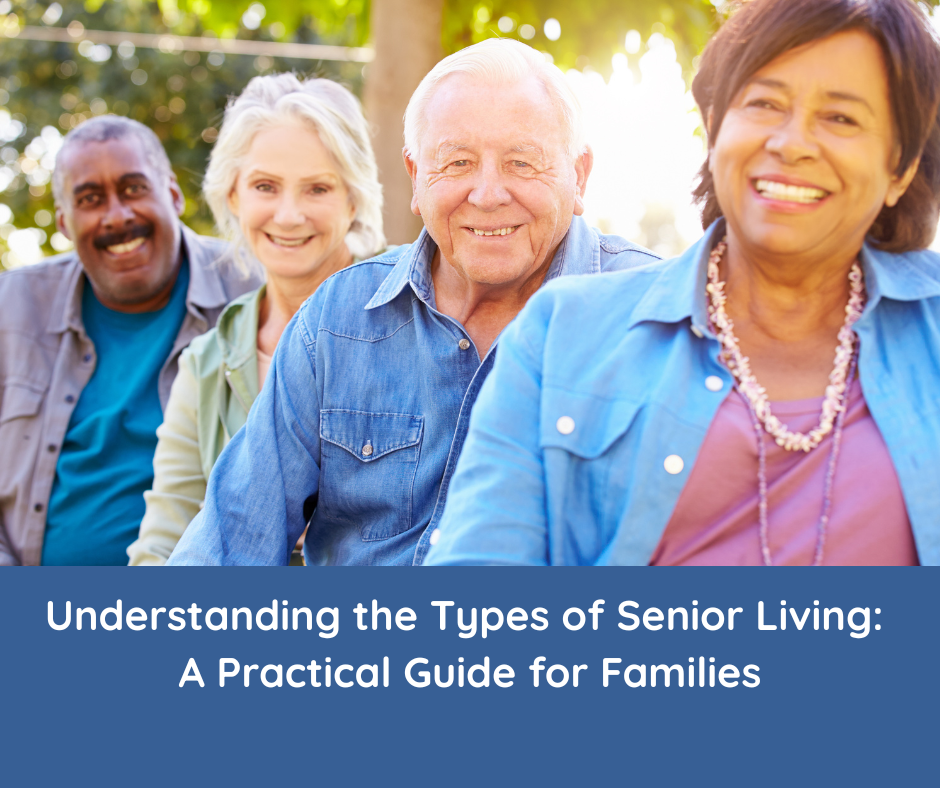Your cart is currently empty!
Understanding the Types of Senior Living: A Practical Guide for Families
When supporting aging parents or loved ones, choosing the right senior living arrangement can be challenging. If you’re exploring senior living for the first time, it’s normal to be confused by the different housing categories; many terms sound alike and franchised facilities might use names tailored specifically to their brand. This guide, Understanding the Types of Senior Living: A Practical Guide for Families, breaks down what each option offers, typical costs, and key considerations to help families make informed decision.

55+ Community Age-Restricted Housing
These are also called active adult communities, retirement communities or age-qualified housing. They’re simply neighborhoods that are just for adults age 55 and up.
Who are they for? Retired or semi-retired adults where at least one resident in the home is age 55 or older. They may or may not allow children in the community, as the Housing for Older Persons act allows 55+ communities to legally exclude younger residents under certain conditions.
- Housing Type: Typically single-family homes, condos, or apartments.
- Services: May or may not include amenities like a clubhouse, pool, lawn care, or organized social events.
- Support or Medical Services: None or very limited. Residents are fully responsible for their own care, meals, transportation, etc.
- Focus: Lifestyle and age-based community living. Think retirement lifestyle, not care.
- Typical Cost: Matches typical mortgage or rent rates in the area.

Independent Living Community
You might also hear these called retirement communities (like the 55 and up communities) or “senior living.”
Who are they for? Independent living is for adults usually age 55 or older who don’t require medical or support services on-site. Independent Living is different than a 55+ community as it usually includes meals, housekeeping, transportation, maintenance, and a calendar of activities. It’s more about ease of lifestyle, not medical need.
- Housing Type: Apartments or cottages within a campus-like setting. While not required, many facilities will have medical alert systems in their residences either mounted on the walls, voice activated or given to residents to wear.
- Services: Usually includes meals, housekeeping, transportation, maintenance, and a full calendar of activities.
- Support or Medical Services: No medical or daily care, but emergency help may be on-site or easily accessible through a medical alert system.
- Focus: Independence with convenience, it’s more of a hospitality model rather than healthcare.
- Cost: Varies depending on geographical location but the national average is $2000 – $4000 per month.
Assisted Living
Assisted living facilities provide daily care with activities of daily living (called ADL’s) but not as much help as a nursing home provides. Residents have their own apartments or rooms with shared common areas.
Who are they for? Seniors needing help with daily activities like bathing, dressing, medication reminders, or mobility support.
- Housing Type: Apartment style; either private or shared with a basic kitchenette
- Services: 24/7 staff for personal care assistance like: medication reminders, mobility, dressing and hygiene
- Support Services: Meals, housekeeping, laundry, transportation and social and recreational programs
- Typical Cost: The national average is $4,000 to $6,500 per month with costs increasing as care needs increase. Usually paid out-of-pocket but some aspects may be covered through Medicaid for individuals that qualify. Coverage varies by state.
Memory Care
Memory care is a specialized type of senior living designed to support those with memory conditions such as Alzheimer’s or Dementia. Oftentimes Memory Care is a dedicated unit that is part of an assisted living or nursing home community.
Who is it for? Individuals with memory related conditions such as Alzheimer’s, dementia, or other cognitive impairments needing specialized supervision and care.
- Housing Type: Individual or shared rooms in a secured and safe facility. Besides having staff specifically trained in memory disorders, the key difference between assisted living and memory care is that memory care has locked and secure units to prevent residents from wandering.
- Services and Support: 24/7 supervision and assistance with ADL’s, structured routines and activities tailored to those with memory disorders, medical staff on site, and a secure environment.
- Focus: Safety and enhancing the quality of life for those with memory disorders.
- Typical Cost: $6,000 to $10,000+ per month. The higher cost reflects specialized care and security needs. While it may cover skilled nurse visits related to memory issues; wound care after an accident that occurred as a result of the memory loss for example, Medicare does not cover Memory Care.
What Are Nursing Homes? And What About Skilled Nursing Facilities?
You might hear a Nursing Home also called a Skilled Nursing Facility (SNF). It’s important to know that all Skilled Nursing Facilities are nursing homes, but not all nursing homes are SNFs. The main difference is that a SNF provides short-term care after a hospital stay while nursing homes offer long-term care for individuals who need ongoing assistance.
Nursing homes are residential facilities with 24/7 supervision and care, designed for those with complex medical needs. You might also hear these called long-term care facilities or convalescent homes.
Who are they for? Seniors with complex medical needs requiring 24-hour nursing care and rehabilitation services. These seniors are too medically fragile for assisted living.
- Housing Type: Private or shared rooms within a clinical, residential care setting that provides 24/7 medical and personal care.
- Services and Support: – All medical management and social activities happen in the nursing home under the supervision of trained staff. Licensed nurses are available around the clock.
- Focus: around-the-clock skilled nursing care and assistance with daily living activities for those with significant medical needs or disabilities who cannot be safely cared for at home or in less intensive settings.
- Typical Cost: $8,000 to $11,000+ per month Medicare covers short-term stays; Medicaid may cover long-term stays depending upon the state and eligibility.

Continuing Care Retirement Communities (CCRCs)
You might hear these referred to as “age in place” option or a “full-service retirement community.”
A CCRC is a comprehensive senior living community that offers multiple levels of care in one location, so residents can move between levels as their needs change without having to leave the community.
Who are the for?
Seniors who want to “age in place” with access to multiple levels of care on one campus, who also have the financial means to pay the entrance fees and ongoing monthly fees that rise as more services are needed and added.
- Housing Type: Independent, assisted living, and nursing care available in a campus style setting.
- Services and Support: Community amenities, meals and social activities and then progressing to assistance with ADL’s and/ or medical care if and when needed.
- Focus: Long-term care living in one location with minimal transition needed between care levels.
Typical Cost: Entrance fees can range from $100,000 to $1 million+. Monthly fees then range from $3,000 to $8,000+ as care progresses. The cost is relatively expensive because it includes housing, meals, social programs, healthcare, and skilled nursing all in one package.
Hospice
Hospice is end-of-life care focused on making the person comfortable, rather than curing them. It provides physical, emotional, and spiritual support for individuals who are terminally ill, along with their families.
- Who is it for? Hospice is for those with a terminal diagnosis comfort-focused care over curative treatment
- Housing Type: Hospice is a care service, so it can happen in the home, the facility where the senior lives, a hospital where the senior was admitted or dedicated hospice facilities.
- Services: The hospice patient receives pain and symptom management as well as emotional and spiritual support administered by hospice nurses, social workers, religious or spiritual counselors and volunteers. Additionally the patient’s loved ones can receive social support if they wish, as well as bereavement support after death occurs.
- Typical Cost: Usually covered by Medicare or Medicaid or traditional health insurance. Private pay is rare.
Understanding the Types of Senior Living: A Practical Guide for Families- More Senior Living Considerations
Home Care
It’s important to mention that families can certainly keep their older loved ones at home as they age. Care provided at home, ranging from non-medical assistance to skilled nursing. Costs vary widely depending on the type of care and can be from $25 to $80+ per hour. Medicare and Medicaid may step in depending upon financial eligibility and the state where the senior lives.
Program for All Inclusive Care for the Elderly (PACE)
PACE provides comprehensive medical and social services to eligible older adults as an alternative to entering a nursing home. Costs and availability depend on your area. PACE supports home caregivers with a place for seniors to receive medical checkups, rehab therapy, meals, and activities several days a week. Transportation is also included. PACE centers operate during the day, but services can be accessed 24/7.
- Who is it for? Adults age 55+ who live at home but have been certified by the state as meeting the need for the nursing home level of care.
- Housing Type: PACE can be an “adult day care” in that care happens during the day but it offers comprehensive medical care and specialized supervision by a team. Participants don’t live at a PACE center, rather they visit several times per week. Caregivers can also come to your home depending on your area.
- Services: via their website, “PACE covers all Medicare Parts A, B and D benefits, all Medicaid-covered benefits, and any other services or supports that are medically necessary to maintain or improve the health status of PACE program participants.”
- Focus: Allowing seniors to remain in their home and community while providing comprehensive medical and support services. This includes relief and resources for their family caregivers.
- Typical Cost: PACE is funded mainly through Medicare and Medicaid. Availability and costs depend on your location but here’s how cost breaks down in general:
- Dual-eligible (Medicare + Medicaid): No monthly premium, out-of-pocket costs are typically minimal
- Medicare only: May pay a monthly premium, often several thousand dollars per month
- Private pay (neither Medicare nor Medicaid): Pay full cost out-of-pocket.
Adult Day Care
Adult day care is daytime support for any adult, regardless of age, who is mostly independent but not safe to be left home alone. Adult day care centers are a senior center, social services facility or private facility.
Costs vary widely as they may be subsidized by Medicaid, Veteran’s Affairs or state programs like Area Agencies on Aging. Many facilities are also private pay, and Medicare does not pay for adult day care. A good start to find adult day care is to search: your county name + Area Agency on Aging.
Long Term Care
“Long term care” (LTC) is an umbrella term that refers to the various housing and care options for those who need ongoing medical attention or assistance with daily activities. So if you hear someone talking about LTC it may be because they’re speaking about services needed that aren’t specified yet. A doctor may say for example, “Your father-in-law had a stroke so he’ll need long-term care after the stroke.” This can mean a nursing home, assisted living, skilled nursing facility or memory care.
LTC is not age dependent; anyone can be in long term care due to illness, injury or disability but 80-85% of residents are seniors.

When it’s Time to Decide
The type of care you or your loved one needs might need to be decided quickly due to an accident or medical event. For that reason, it’s important to have a Durable Power of Attorney, as well as an Advanced Directive in place. This way your wishes for living space and healthcare are plainly documented in the event that you or your loved one are unable to communicate your wishes. Whatever choice is made, facilities almost always have a dedicated support staff to guide you, and there are also outside resources to support you.
Leave a Reply